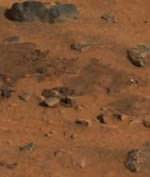
Image credit: NASA/JPL
Engineers have found that Spirit’s landing on Mars didn’t go quite as smoothly as they’d hoped. It turns out that the protective airbags haven’t fully retracted, and could snag the rover’s solar panels as it tries to get off the landing platform. Their current plan is to lift up the landing flap, try to pull the airbag back in, and then drop the flap again. The rover sent home the first high-resolution stereo images from the surface of Mars, which have provided new details about the rover’s environment – an enticing target is a low hill approximately 2 km away which could show layers of sediment.
The engineers and scientists for NASA’s Spirit are eager to get the rover off its lander and out exploring the terrain that Spirit’s pictures are revealing, but caution comes first.
An added “lift and tuck” to get deflated airbag material out of the way extends the number of activities Spirit needs to finish before it can get its wheels onto martian ground.
“We’ll lift up the left petal of the lander, retract the airbag, then let the petal back down,” said Art Thompson, rover tactical uplink lead at NASA’s Jet Propulsion Laboratory, Pasadena, Calif. This and other added activities have pushed the earliest scenario for roll-off to Jan. 14, and it could be later.
The first stereo image mosaic from Spirit’s panoramic camera provided new details of the landscape’s shapes, including hills about 2 kilometers (1.2 miles) away that scientists are discussing as a possible drive target for the rover. The rover’s infrared sensing instrument, called the miniature thermal emission spectrometer, has begun returning data about the surroundings, too, indicating that it is in good health. Now, positive health reports are in for all of Spirit’s science instruments.
The rover carried out commands late Tuesday to pull in the cords to its base-petal airbags with three turns of the airbag retraction motor. “We got about a 5 centimeter (2 inch) lowering of the airbag to the left of the front of the lander, which is the one we’re most concerned about,” said JPL’s Arthur Amador, mission manager. “That airbag is still a little too high, and we’re concerned that we might hit it with our solar panel on the way down.”
The rover could also turn to roll off in a different direction, but the maneuver to lift a petal and pull airbags further under it is designed to improve conditions for exiting to the front.
“We have experienced a couple of hiccups, so we’re being very cautious about how we deal with them,” Thompson said. One concern from Sunday and Monday was resolved late Tuesday, when results of testing a motor that moves the high-gain antenna showed no sign of a problem.
“We’re chomping at the bit to get this puppy off the lander,” Thompson said.
Dr. Ray Arvidson of Washington University in St. Louis, Mo., deputy principal investigator for the rover’s science instruments, said the science team gathered in Pasadena has been offering diverse theories for how the landscape surrounding Spirit was shaped, and anticipating ways to test the theories with the rover’s instruments.
“A lake bed is typically flat, with very fine-grain sediments,” Arvidson said. “That’s not what we’re looking at. If these are lake sediments, then they’ve been chewed up by impacts and rocks have been brought in.”
Besides looking forward to exploring away from the lander, the rover teams are looking forward to getting Spirit’s twin Mars Exploration Rover, Opportunity, safely landed on Mars. Atmospheric conditions in the region of Opportunity’s landing site are being monitored from orbit, said Dr. Joy Crisp, project scientist for both rovers. Information about the actual conditions Spirit experienced on its descent through Mars’ atmosphere are being compared with the conditions predicted ahead of time in order to refine the predictions for what Opportunity will experience.
Spirit arrived at Mars Jan. 3 (EST and PST; Jan. 4 Universal Time) after a seven-month journey. Its task is to spend the next three months exploring for clues in rocks and soil about whether the past environment at this part of Mars was ever watery and suitable to sustain life.
Spirit’s twin Mars Exploration Rover, Opportunity, will reach its landing site on the opposite side of Mars on Jan. 25 (EST and Universal Time; Jan. 24 PST) to begin a similar examination of a site on the opposite side of the planet from Gusev Crater.
JPL, a division of the California Institute of Technology in Pasadena, manages the Mars Exploration Rover project for NASA’s Office of Space Science, Washington, D.C. Additional information about the project is available from JPL at http://marsrovers.jpl.nasa.gov and from Cornell University, Ithaca, N.Y., at http://athena.cornell.edu.
Original Source: NASA/JPL News Release
